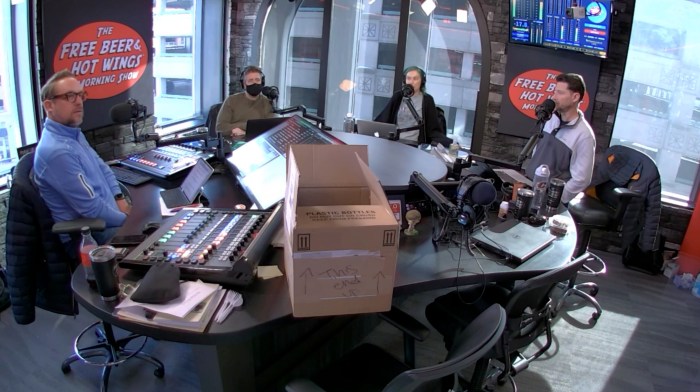For a segment of a radio show – Join us as we delve into the captivating world of radio segments, where understanding your target audience is the key to unlocking their hearts and minds. In this comprehensive guide, we’ll explore the art of creating engaging content, crafting compelling structures, and harnessing the power of technology to deliver unforgettable segments that resonate with your listeners.
From identifying your audience’s unique needs to mastering the technical aspects of audio production, we’ll provide you with actionable strategies and expert insights to elevate your radio segments to new heights.
Target Audience Identification

Understanding your target audience is crucial for the success of any radio show. By identifying their specific demographics, interests, and listening habits, you can tailor your content to resonate with them, keeping them engaged and coming back for more.
To gather insights into your audience, conduct thorough audience research. Use surveys, focus groups, and social media listening tools to collect data on their age, gender, location, education level, occupation, and interests. Additionally, analyze their listening patterns, such as when they tune in, how long they listen, and which segments they prefer.
Market Segmentation
Once you have a clear understanding of your target audience, you can segment them into smaller, more manageable groups based on their shared characteristics. This allows you to tailor your content to each segment’s specific needs and interests, ensuring that your show remains relevant and engaging.
Content Development

Crafting compelling radio segments that resonate with your target audience demands a strategic approach to content development. Successful radio segments effectively tap into the interests, values, and aspirations of their listeners.
Strategies for Engaging Content
- Conduct thorough audience research:Understand your target audience’s demographics, listening habits, and interests to tailor your content accordingly.
- Identify compelling topics:Choose topics that are relevant, informative, and entertaining to your audience. Consider trending news, current events, or topics that spark discussion and debate.
- Use storytelling and humor:Engage your listeners by weaving personal anecdotes, real-life stories, and humor into your segments. This creates an emotional connection and makes your content more relatable.
- Incorporate interactive elements:Encourage audience participation through call-ins, polls, or social media interactions. This fosters a sense of community and keeps listeners engaged.
Successful Radio Segments
Here are examples of successful radio segments that effectively targeted specific audience segments:
- NPR’s “Planet Money”:A podcast that explores economic concepts in a fun and accessible way, appealing to a broad audience interested in current events and financial literacy.
- BBC’s “Woman’s Hour”:A long-running program that discusses issues affecting women, providing a platform for diverse perspectives and empowering its female listeners.
- “The Joe Rogan Experience”:A podcast that features in-depth conversations with guests from various fields, attracting a large and diverse audience with its wide-ranging topics and unconventional format.
Segment Structure

A radio segment typically follows a three-part structure: introduction, body, and conclusion.
The introduction sets the stage for the segment, introducing the topic and engaging the listeners. It should be concise, informative, and attention-grabbing.
Body
The body of the segment is where the main content is presented. It should be well-organized and flow smoothly from one point to the next. The content should be presented in a clear and engaging manner, with supporting evidence and examples to support the points being made.
Transitions
Transitions are an important part of a radio segment. They help to connect the different parts of the segment and keep the flow of information smooth. Transitions can be as simple as a brief pause or a short verbal cue, or they can be more elaborate, such as a musical interlude or a sound effect.
Hey listeners, we’re back with another segment of our show where we dive into the nitty-gritty of various topics. Today, we’re tackling the fascinating subject of depreciation on x-ray machines . Stick with us as we explore the ins and outs of this topic.
Pacing
Pacing is also important in a radio segment. The pace should be varied to keep the listeners engaged. Faster pacing can be used to create excitement or urgency, while slower pacing can be used to emphasize important points or to create a more relaxed atmosphere.
Technical Considerations

Technical considerations are crucial for producing high-quality radio segments that effectively engage listeners. From sound quality to editing and mixing, every aspect plays a significant role in enhancing the impact of your content.
Sound Quality, For a segment of a radio show
- Use high-quality microphones and recording equipment to capture clear and crisp audio.
- Ensure proper microphone placement and adjust levels to minimize background noise and distortion.
- Test and optimize the acoustics of your recording space to prevent echoes or reverberations.
Editing and Mixing
Editing and mixing allow you to refine your audio, remove unwanted sections, and enhance the overall flow of your segment.
- Edit out any unnecessary pauses, hesitations, or distractions.
- Adjust volume levels to ensure a balanced and consistent sound throughout.
- Use fade-ins and fade-outs to smoothly transition between sections.
Sound Effects, Music, and Voice Modulation
Sound effects, music, and voice modulation can add depth and emotion to your segment.
- Use sound effects sparingly to illustrate points or create atmosphere.
- Choose music that complements the tone and mood of your content.
- Modulate your voice to convey different emotions or emphasize key points.
Optimizing for Different Platforms
Consider the platform where your segment will be aired and optimize it accordingly.
- For FM radio, ensure that your audio is loud enough to be heard clearly in a noisy environment.
- For podcasts, optimize your segment for easy download and playback on various devices.
- For streaming services, consider using metadata to help listeners discover and categorize your content.
Promotion and Engagement: For A Segment Of A Radio Show

Promoting your radio segment effectively is crucial for attracting and engaging listeners. Social media platforms, email marketing, and other channels play a vital role in reaching your target audience and generating interest in your content.
During the segment, encourage listener participation by inviting them to call in, text, or engage with you on social media. This creates a sense of community and makes listeners feel valued and connected to the show.
Measuring Success
To gauge the success of your segment, track metrics such as listenership, engagement, and feedback. Listenership data can be obtained from radio station analytics or third-party measurement tools. Engagement metrics, such as the number of calls, texts, or social media interactions, indicate the level of audience involvement.
Feedback from listeners, through surveys or online reviews, provides valuable insights into their preferences and areas for improvement.
Frequently Asked Questions
What is the most important factor to consider when creating a radio segment?
Understanding your target audience’s demographics, interests, and listening habits is crucial for creating content that resonates with them.
How can I make my radio segments more engaging?
Incorporate storytelling, humor, and interactive elements to capture and maintain listener attention.
What is the typical structure of a radio segment?
A typical segment includes an introduction, body, and conclusion, with clear transitions and pacing to enhance listener engagement.